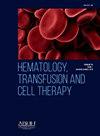egfr靶向肽抑制hela细胞增殖:宫颈癌治疗的新策略?
IF 1.8
Q3 HEMATOLOGY
引用次数: 0
摘要
引言/理由宫颈癌仍然是全球女性癌症相关死亡的主要原因之一,EGFR过表达导致不受控制的增殖、细胞凋亡抵抗和肿瘤进展。尽管放疗和化疗取得了进展,但许多患者产生了耐药性,这突出表明迫切需要能够破坏这些致癌途径的靶向治疗。基于肽的药物具有高特异性、低毒性和抑制癌症关键分子驱动因素的潜力,是精确肿瘤学的一个有前途的途径。本研究研究了设计用于与EGFR相互作用的YHWYGYTPQNVT肽,并评估其对HeLa细胞增殖和迁移的影响,HeLa细胞是一种广泛使用的宫颈癌模型。本研究旨在通过分析HeLa细胞的增殖、代谢活性和迁移,确定YHWYGYTPQNVT肽是否能有效抑制egfr介导的HeLa细胞生长信号,旨在确定其作为传统癌症治疗替代方案的潜力。材料与方法采用固相肽合成法合成YHWYGYTPQNVT肽,HPLC纯化,质谱确证。在DMEM + 10%胎牛血清中培养HeLa细胞,在37℃、5% CO₂中培养。为了建立基线增殖率,将HeLa细胞以5 × 104个细胞在6孔板中接种,在5天的时间内进行六次生长曲线,在第1、3和5天进行细胞计数。实验组用80µmol/mL的YHWYGYTPQNVT处理细胞。采用GraphPad Prism进行统计学分析,p≤0.05为显著性。结果高效合成了YHWYGYTPQNVT肽,产率约为45%。HPLC和质谱分析证实了肽的整个合成、裂解和纯化过程都是有效的。对照组显示出指数增长的侵袭性增殖率,达到~ 96.8 × 10⁴细胞,与已知的HeLa细胞的致癌潜力一致。相比之下,肽处理组的增殖显著减少,最终细胞计数平均为61.5 × 10⁴细胞-与未处理的细胞相比,减少25.5%。结论YHWYGYTPQNVT是一种很有前景的egfr靶向药物,能够减少宫颈癌细胞的增殖。通过直接干扰egfr驱动的致癌途径,这种方法可以为肿瘤中一类新的基于肽的治疗方法奠定基础。为了确定其在egfr过表达宫颈肿瘤患者中的潜在临床应用,还需要进一步的体内验证和分子通路分析。本文章由计算机程序翻译,如有差异,请以英文原文为准。
EGFR-TARGETING PEPTIDE INHIBITS HELA CELL PROLIFERATION: A NOVEL STRATEGY FOR CERVICAL CANCER THERAPY?
Introduction/Justification
Cervical cancer remains one of the leading causes of cancer-related mortality in women worldwide, with EGFR overexpression contributing to uncontrolled proliferation, resistance to apoptosis, and tumor progression. Despite advances in radiotherapy and chemotherapy, many patients develop resistance, highlighting the urgent need for targeted therapies that can disrupt these oncogenic pathways. Peptide-based drugs represent a promising avenue for precision oncology, offering high specificity, low toxicity, and potential to inhibit key molecular drivers of cancer. This study investigates the YHWYGYTPQNVT peptide, designed to interact with EGFR, and evaluates its effect on proliferation and migration of HeLa cells, a widely used model of cervical cancer.
Objectives
This research aims to determine whether the YHWYGYTPQNVT peptide can effectively suppress EGFR-mediated growth signaling in HeLa cells, by analyzing cell proliferation, metabolic activity, and migration, aiming at establishing its potential as a therapeutic alternative to traditional cancer treatments.
Materials and Methods
The YHWYGYTPQNVT peptide was synthesized using solid-phase peptide synthesis, purified via HPLC, and confirmed by mass spectrometry. HeLa cells were cultured in DMEM + 10% fetal bovine serum and incubated at 37°C with 5% CO₂. To establish a baseline proliferation rate, HeLa cells were plated at 5 × 104 cells in 6-well plates, and the growth curve was performed in sextuplicate over a 5-days period, with cell counts conducted on days 1, 3 and 5. For the experimental group, cells were treated with YHWYGYTPQNVT (80 µmol/mL). Statistical analysis was conducted using GraphPad Prism, with significance set at p ≤ 0.05.
Results
The YHWYGYTPQNVT peptide was synthesized efficiently with yield of approximately 45%. Chromatographic analyzes obtained by HPLC and mass spectrometry confirmed that the entire synthesis, cleavage, and purification process of peptides were performed efficiently. Control group displayed an aggressive proliferation rate with an exponential growth, reaching ∼96.8 × 10⁴ cells, consistent with the known oncogenic potential of HeLa cells. In contrast, the peptide-treated group showed a significant reduction in proliferation, with final cell counts averaging 61.5 × 10⁴ cells - corresponding to a 25.5% decrease compared to untreated cells.
Conclusion
Our findings highlight YHWYGYTPQNVT as a promising EGFR-targeting agent capable of reducing cervical cancer cell proliferation. By directly interfering with EGFR-driven oncogenic pathways, this approach could lay the groundwork for a new class of peptide-based therapeutics in oncology. Further in vivo validation and molecular pathway analysis are necessary to determine its potential clinical application in patients with EGFR-overexpressing cervical tumors.
求助全文
通过发布文献求助,成功后即可免费获取论文全文。
去求助
来源期刊

Hematology, Transfusion and Cell Therapy
Multiple-
CiteScore
2.40
自引率
4.80%
发文量
1419
审稿时长
30 weeks
 求助内容:
求助内容: 应助结果提醒方式:
应助结果提醒方式:


